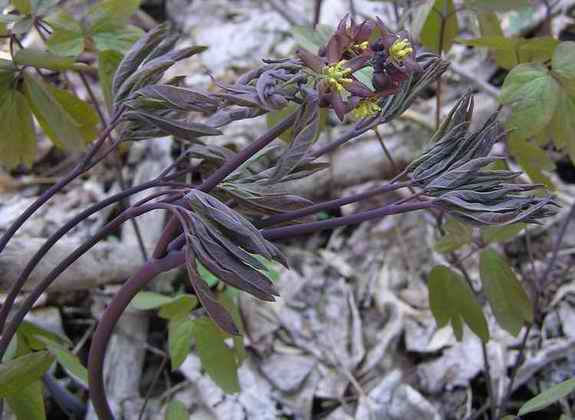|
Return to Hiker's Notebook Home Page
Common Name: Blue Cohosh, Squawroot, Papoose root, Blueberry root, Blue ginseng, Yellow ginseng, Beech drops, Caulophylle faux-pigamon (French) - Cohosh is an anglicized Algonquian Indian word that comes from the word koshki, which means "it is rough" in the Natick dialect of the Massachuset language. This refers to the rough texture of the root of the plant. It is further distinguished as blue due to the distinct coloration of its stems and leaves.
Scientific Name: Caulophyllum thalictroides - The generic name is a combination of the Greek words for stalk or stem, kaulo and tribe or race, phylon (from which taxonomic grouping phylum is also derived); this is because the berry-like seeds are on inflated stalks. The specific name is taken from Thalictrum, the genus of the meadow rues. This is to indicate that the leaves of the blue cohosh have a segmented lobe mitten-like shape that is similar to that of the meadow rues.
The Indian word koshki from which cohosh was derived denoted a number of plants which were used medicinally. Black Cohosh (Cimicifuga racemosa) is in the Buttercup Family; Blue Cohosh is in the Barberry Family. The roots of both plants were predominantly used in the treatment of a variety of parturition related problems. This gave rise to the anachronistically descriptive though now pejorative alternative common names Squawroot and Papoose root. Squaw is from the Algonquian squa for "female creature" and was typically used disparagingly; papoos is Narraganset for "very small" and applied to small children. White Baneberry (Actaea pachypoda) is also called White Cohosh.
Blue Cohosh was used by different Indian tribes according to their own particular experiences and traditions. The Menominee Indians ground the root into a powder to make a tea for the mitigation of profuse menstruation. The Cherokee used it in a broader application to promote childbirth, to reduce inflammation of the uterus, to relieve toothaches and even to treat hysteria. The Chippewa used it as a contraceptive, to treat pulmonary problems and to ease indigestion. The Iroquois used it in the treatment of a variety of maladies including rheumatism, gastrointestinal cramps, gallstones, and, as a general purpose tonic in the treatment of fever.
The early colonists adopted these practices and Blue Cohosh accordingly evolved into a folk remedy for a number of medical conditions. It was listed in the U. S. Pharmacopoeia from 1882 to 1905 as an herb to induce labor during the parturition process and has historically been prescribed by doctors for the treatment of a number of inimical uterine diseases. The alternative names blue and yellow ginseng afford the mnemonic association of C. thalictroides with the more widely known herbal medicinal Panax quinquefolium; blue distinguishes the blue seeds from the red berries of the real ginseng, yellow calls to mind its prominent yellow sepals of the Blue Cohosh flower.
Blue Cohosh is marketed widely as an herbal treatment for a wide range of medical conditions associated with the female gender. This has led to some concern for its extirpation by unscrupulous harvesters. Like all so-called herbal remedies, it has not been evaluated by the FDA for efficacy or safety; its purported beneficence is based on hearsay and anecdote. The predominant claim is that it is a "uterine tonic" that ameliorates the tissue of the uterus following pregnancy, miscarriage or abortion. It is recommended for use during the latter stages of a pregnancy to tone the uterus and facilitate delivery, to ease labor pains during the parturition process, to induce labor, and to reduce postpartum bleeding. In a survey of 174 certified nurse-midwives, 90 recommended labor-stimulating herbal supplements with some recommending Blue Cohosh, some Black Cohosh, and some a combination of the two. However, there is some controversy over the efficacy of Blue Cohosh taken during pregnancy; instances of infantile stroke and pulmonary edema have been reported.
The medicinal effects of Blue Cohosh evinced interest for the conduct of scientific research to determine its constituent chemistry in the middle of the 20th Century. Auguste Mockle, a Canadian pharmaceutical researcher, found that the root contained a glycoside (sugar compound) named caulosaponin that induced strong uterine contractions. It is this chemical, unique to Blue Cohosh and named from its genus Caulophyllum, that gives the plant its medicinal properties. More recent research in India using animals has shown some ovulation inhibiting effects, confirming its reported use as a contraceptive.
Ironically, Blue Cohosh is recommended as an abortifacient due to its pronounced effect on the uterus. It is reportedly used in conjunction with Black Cohosh and American Pennyroyal (Hedeoma pulegioides), another abortifacient plant. However, there are many contraindications of Blue Cohosh that should render its use highly suspect. It contains methylcytisine, an alkaloid that increases blood pressure and causes hypoglycemia, high blood sugar. It has a overstressing effect on the liver and kidneys; other reported side effects include vomiting and headache. |
